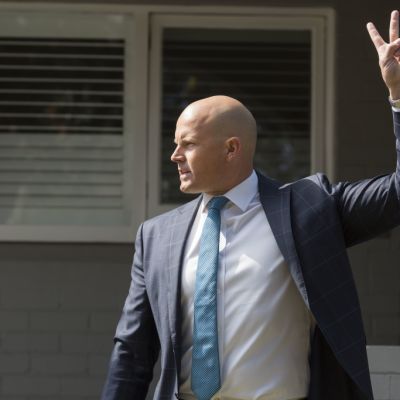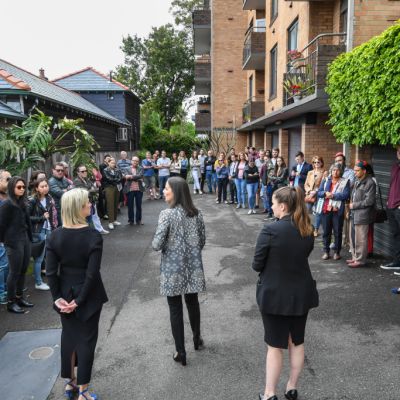Australia's remarkable property price turnaround: National house prices regain a third of losses in past two years
Australia’s housing market has recorded a remarkable recovery led by the capital cities that experienced the steepest downturn.
The national median house price has bounced back 2.7 per cent to $773,635 in the past three months ending September, according to the latest Domain House Price Report released on Thursday.
The national median unit price bounced back 1.8 per cent to $539,256 in the same period.
Domain senior research analyst Dr Nicola Powell said it was the first national quarterly growth Australia had seen since December 2017.
“The ability to service a mortgage has fallen, prices are still below their peak … [and] we have seen a subtle relaxation of lending,” Dr Powell said. “All of these factors together is helping drive that recovery.”
From peak to trough, the national median house price lost almost $65,000, Dr Powell said.
“They’ve now regained $21,000. They’ve regained about a third since the downturn. That’s a pretty stark comparison,” she said.
It was a similar story for units, with the median price shaving off about $43,000, she said.
“They’ve regained just $9000 … they’ve regained almost a quarter.”
House and units prices have rallied on a national level largely thanks to buoyant property markets in Sydney and Melbourne.
Median house prices
| Capital city | Sep-19 | QoQ | YoY |
| Sydney | $1,079,491 | 4.80% | -1.60% |
| Melbourne | $855,428 | 4.10% | 0.00% |
| Brisbane | $562,847 | -1.00% | -1.80% |
| Adelaide | $538,550 | -0.60% | 0.70% |
| Canberra | $738,864 | -0.70% | 0.60% |
| Perth | $527,107 | -1.00% | -2.40% |
| Hobart | $482,960 | 1.30% | 2.60% |
| Darwin | $521,651 | 1.00% | -4.40% |
| National (excludes Darwin) | $773,635 | 2.70% | -1.00% |
| Source: Domain House Price Report | |||
Sydney
Sydney’s steepest downturn since the 1980s has come to an end with the harbour city recording its fastest quarterly comeback – four times greater than any other three-month period.
The median house price jumped 4.8 per cent, gaining almost $50,000, to $1,079,491.
Unit prices rose 2.6 per cent to $694,840.
The surprise federal election result, which locked in favourable housing policies for investors like capital gains tax and negative gearing, slightly relaxed lending and falling interest rates had helped undecided buyers jump into the market.
“Buyers have been waiting on the fence … we’re seeing pent-up demand and some of those buyers are coming to the table,” Dr Powell said, adding that even more buyers would be attracted in anticipation of further rate cuts in the future.
She said despite the rebound, both house and unit prices remained lower than they were a year ago.
House prices are 9.9 per cent below the mid-2017 peak and unit prices 10.6 per cent below.
Melbourne
Melbourne house prices rebounded for a second consecutive quarter, also marking the end of its steepest downturn in two decades and recording the fastest recovery for the city in its property history.
Prices have rallied 5.5 per cent overall since the market bottomed out in March.
The median house price jumped 4.1 per cent in the quarter to $855,428, recovering half the money lost in the downturn, according to Dr Powell.
Melbourne unit prices have also bucked the national downward trend and hit their highest point on record in the September quarter, rising 3.6 per cent to $520,940. It is now the second-most expensive city to buy a unit.
“Falling interest rates have aided mortgage serviceability,” Dr Powell said. “Together with changes to serviceability assessment, mortgage lending has increased in recent months. The acceleration of prices is also supported by the exceptionally strong population and jobs growth.”
Brisbane
Brisbane property prices continued their decline – it was one of only two capital cities to record house price falls over the quarter and year.
Greater Brisbane’s median house price nudged down 1 per cent in the quarter to $562,847.
For units, prices fell 3.4 per cent to $375,179 in the same period. However over the year, they fell 5.6 per cent – the steepest annual drop in over 18 years.
Dr Powell said increased affordability has allowed buyers to purchase at a six-year low.
“Unit prices are 9 per cent below the 2016 peak, representing a $37,000 reduction,” Dr Powell said. “The ongoing decline in units has largely been explained by high levels of supply.”
Adelaide
Adelaide’s property market was subdued in the September quarter with house prices slipping from the record high achieved in the previous quarter.
The city’s median house price slipped 0.6 per cent to $538,550.
Units dropped 5.2 per cent to $302,756, making it the second most affordable of capital city to buy a unit, only behind Darwin.
Dr Powell said South Australia’s weaker job market had weighed on housing demand.
“Unemployment has been rising for more than a year, the second highest rate behind Queensland,” she said, adding that further declines in unit prices could be an indication that houses were the preferred type of home in Adelaide on top of higher levels of unit construction in the past year.
Median unit prices
| Capital city | Sep-19 | QoQ | YoY |
| Sydney | $694,840 | 2.60% | -5.00% |
| Melbourne | $520,940 | 3.70% | 6.30% |
| Brisbane | $375,179 | -3.40% | -5.60% |
| Adelaide | $302,756 | -5.20% | -2.30% |
| Canberra | $432,252 | -4.40% | -3.40% |
| Perth | $344,672 | 2.80% | -1.90% |
| Hobart | $395,715 | 1.70% | 10.40% |
| Darwin | $294,951 | -3.30% | -7.10% |
| National (excludes Darwin) | $539,256 | 1.80% | -2.00% |
| Source: Domain House Price Report | |||
Perth
Buyers continued to have the upper hand in Perth’s property market with house prices 14.4 per cent below the peak and unit prices 18.2 per cent lower than 2014 record highs.
The West Australian capital saw a 2.8 per cent increase in the median unit price to $344,672.
Meanwhile, the median house price fell a marginal 1 per cent to $527,107.
But Dr Powell said price falls had moderated, showing improved conditions across the housing market.
“The supply of new dwellings has been constrained, helping to create more competition among buyers,” she said. “With asking rents rising, rental yields improving, and lower purchasing prices, it makes Perth houses a more attractive investment.”
Hobart
For investors, Hobart remains the best performing city for capital growth.
Both house and unit prices experienced the strongest annual gain compared to the mainland cities.
The city’s house median grew 1.3 per cent in the past quarter to $482,960 – still the cheapest capital across the country.
Units grew 1.7 per cent in the past quarter and a whopping 10.4 per cent in the past year to $395,715, overtaking Brisbane for the first time this year.
Dr Powell said population-fuelled housing demand continued to influence price growth but the pace had eased from the booming double-digit highs.
“Despite the median house price increasing about $12,000 over the year, Hobart remains the most affordable capital city,” she said. “That said, with the lowest average wage, affordability has become increasingly stretched for local buyers.”
Canberra
Canberra house prices continued to weaken for the third consecutive quarter falling 0.7 per cent to $738,864.
Units fell even more by 4.4 per cent to $432,252.
Despite these drops, the city’s property market remains the third-highest of all the capital city markets.
Dr Powell said home owners in the nation’s capital continued to enjoy steady equity growth, which has risen annually for just over six years.
Darwin
Darwin recorded a mixed bag for house and unit price in the past quarter as it continued to be affected by weak economic conditions brought on by the end of the mining boom.
The city’s unit prices declined 3.3 per cent to $294,951 – making it the cheapest capital city to purchase a unit. But the median house price increased by 1 per cent to $521,651.
Dr Powell said prices remained well below peak values seen between 2013-16 when mining related construction was at its height in the Northern Territory.
“Population growth continues to drag on the housing market,” she said. “The decline in migrants from interstate and overseas may have reached a trough at the end of 2018, but … any upswing in the Darwin property market may still be a while away.”
We recommend
We thought you might like
States
Capital Cities
Capital Cities - Rentals
Popular Areas
Allhomes
More










